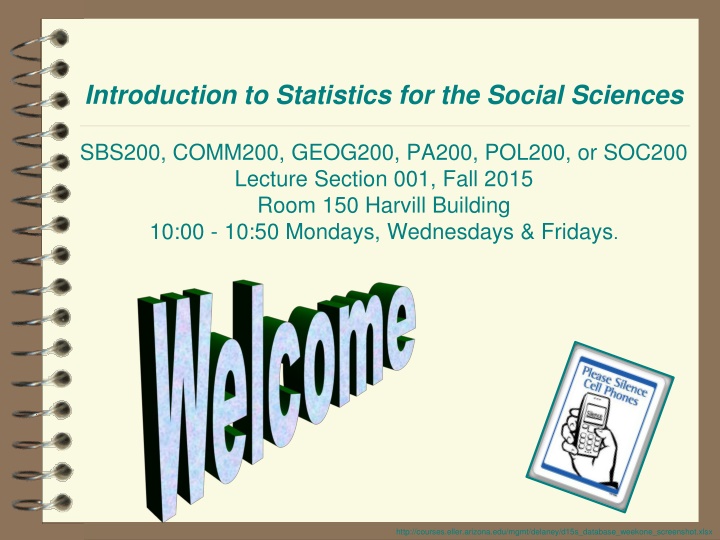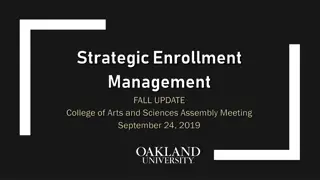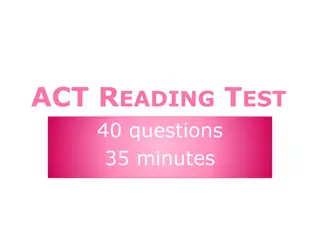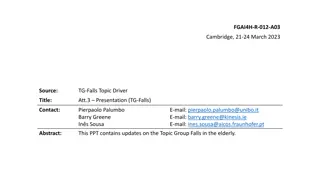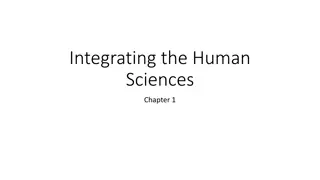Introduction to Statistics for Social Sciences Fall 2015
In this course, students are encouraged to review for Exam 3 while preparing for the upcoming test by reading specific chapters. There are no new homework assignments, so students are advised to focus on studying. The importance of enrolling in lab sessions is emphasized through practical race analysis scenarios involving independent and dependent variables. Albert's study on jockeys' race times helps illustrate key concepts in statistical analysis for social sciences.
Download Presentation

Please find below an Image/Link to download the presentation.
The content on the website is provided AS IS for your information and personal use only. It may not be sold, licensed, or shared on other websites without obtaining consent from the author.If you encounter any issues during the download, it is possible that the publisher has removed the file from their server.
You are allowed to download the files provided on this website for personal or commercial use, subject to the condition that they are used lawfully. All files are the property of their respective owners.
The content on the website is provided AS IS for your information and personal use only. It may not be sold, licensed, or shared on other websites without obtaining consent from the author.
E N D
Presentation Transcript
Introduction to Statistics for the Social Sciences SBS200, COMM200, GEOG200, PA200, POL200, or SOC200 Lecture Section 001, Fall 2015 Room 150 Harvill Building 10:00 - 10:50 Mondays, Wednesdays & Fridays. http://courses.eller.arizona.edu/mgmt/delaney/d15s_database_weekone_screenshot.xlsx
By the end of lecture today 11/16/15 Reviewing for Exam 3
Before next exam (November 20th) Please read chapters 1 11 + 13 in OpenStax textbook Please read Chapters 2, 3, and 4 in Plous Chapter 2: Cognitive Dissonance Chapter 3: Memory and Hindsight Bias Chapter 4: Context Dependence
No new Homework Assignments Please review (or redo) previous assignments to help study for Exam 3 Just study for Exam 3
Everyone will want to be enrolled in one of the lab sessions Labs continue this week
Lets try one Albert compared the time required to finish the race for 20 female jockeys and 20 male jockeys riding race horses. He wanted to know who averaged faster rides. Which of the following is true? a. The IV is gender while the DV is time to finish a race b. The IV is time to finish a race while the DV is gender
Lets try one Albert compared the time required to finish the race for 20 female jockeys and 20 male jockeys riding race horses. He wanted to know who averaged faster rides. The independent variable is a(n) _____ a. Nominal level of measurement b. Ordinal level of measurement c. Interval level of measurement d. Ratio level of measurement
Lets try one Albert compared the time required to finish the race for 20 female jockeys and 20 male jockeys riding race horses. He wanted to know who averaged faster rides. The dependent variable is a(n) _____ a. Nominal level of measurement b. Ordinal level of measurement c. Interval level of measurement d. Ratio level of measurement
Lets try one Albert compared the time required to finish the race for 20 female jockeys and 20 male jockeys riding race horses. He wanted to know who averaged faster rides. The independent variable is a(n) _____ a. Discrete b. Continuous
Lets try one Albert compared the time required to finish the race for 20 female jockeys and 20 male jockeys riding race horses. He wanted to know who averaged faster rides. The dependent variable is a(n) _____ a. Discrete b. Continuous
Lets try one Albert compared the time required to finish the race for 20 female jockeys and 20 male jockeys riding race horses. He wanted to know who averaged faster rides. Which of the following is true? a. This is a quasi, between participant design b. This is a quasi, within participant design c. This is a true, between participant design d. This is a true, within participant design
Lets try one Albert compared the time required to finish the race for 20 female jockeys and 20 male jockeys riding race horses. He wanted to know who averaged faster rides. Which of the following is true? a. This is t-test b. This is an ANOVA c. This is a correlational design d. This is a chi square
Lets try one Albert compared the race times of 20 male and female jockeys for race horses. He wanted to know who averaged faster rides. Which of the following is true? a. The IV is gender while the DV is time to finish a race b. The IV is time to finish a race while the DV is gender
Lets try one Albert compared the race times of 20 male and female jockeys for race horses. He wanted to know who averaged faster rides. Which of the following is true? a. The null hypothesis is that there is no difference in race times between the genders b. The null hypothesis is that there is a difference between the genders
Which would be a Type II error? Let s try one Albert compared the race times of 20 male and female jockeys for race horses. He wanted to know who averaged faster rides. A Type I Error would claim that: a. There is a difference when in fact there is b. There is a difference when in fact there isn t one c. There is no difference when in fact there isn t one d. There is no difference when in fact there is a difference
Lets try one Albert compared the race times of 20 male and female jockeys for race horses. He wanted to know who averaged faster rides. He concluded p < 0.05 what does this mean? a. There is a significant difference between the means b. There is no significant difference between the means
Lets try one Albert compared the race times of 20 male and female jockeys for race horses. He wanted to know who averaged faster rides. Which of the following is true? a. This is a one-tailed test b. This is a two-tailed test
Lets try one Albert compared the race times of 20 male and female jockeys for race horses. He predicted that men would average faster rides. Which of the following is true? a. This is a one-tailed test b. This is a two-tailed test
Lets try one Albert compared the race times of 20 male and female jockeys for race horses. He wanted to know who averaged faster rides. Which of the following is best describes his results? a. t(198) = 2.38; p < 0.05 b. t(198) = 2.38; ns c. t(198) = 1.97; p < 0.05 d. t(198) = 1.97; ns
Lets try one Albert compared the race times of 20 male and female jockeys for race horses. He wanted to know who averaged faster rides. Which of the following is best describes his results? a. t(198) = 2.38; p < 0.01 b. t(198) = 2.38; ns c. t(198) = 1.97; p < 0.01 d. t(198) = 1.97; ns
An ANOVA was conducted comparing which type of horse is the fastest (Arabians, Thoroughbreds, or Quarter Horses). We measured how long it took to finish the race. We measured 11 of each type of horse (33 altogether) Please complete this ANOVA table. Degrees of freedom between is _____; degrees of freedom within is ____ a. 30; 2 b. 2; 30 c. 80; 3 d. 3; 80 correct
An ANOVA was conducted comparing which type of horse is the fastest (Arabians, Thoroughbreds, or Quarter Horses). We measured how long it took to finish the race. We measured 11 of each type of horse (33 altogether) Mean Square Between is ____ while Mean Square Within is ______ a. 80; 2 b. 2; 80 c. 30; 40 d. 40; 30 correct
An ANOVA was conducted comparing which type of horse is the fastest (Arabians, Thoroughbreds, or Quarter Horses). We measured how long it took to finish the race. We measured 11 of each type of horse (33 altogether) Please complete this ANOVA table. The F ratio is a. .75 b. 1.3 c. 1.5 d. 1.75 correct
The critical F ratio a. 2.84 b. 2.92 c. 3.23 d. 3.32 correct
The observed F is 1.3 and the critical F ratio is 3.32. What should we conclude? a. reject the null hypothesis b. do not reject the null hypothesis c. p < 0.5 d. both a and c are true correct
An ANOVA was conducted comparing which type of horse is the fastest (Arabians, Thoroughbreds, or Quarter Horses). We measured how long it took to finish the race. We measured 11 of each type of horse (33 altogether) Please complete this ANOVA table. The observed F is 2 and the critical F ratio is 3.32. F(2, 30) = ___; n.s. Please fill in the blank a. 3.32 b. 1.3 c. 30 d. 40 correct
A t-test was conducted to see whether Bankers or Retailers spend more time in front of their computer. Which best summarizes the results from this excel output: a. Bankers spent significantly more time in front of their computer screens than Retailers, t(3.5) = 8; p < 0.05 b. Bankers spent significantly more time in front of their computer screens than Retailers, t(8) = 3.5; p < 0.05 c. Retailers spent significantly more time in front of their computer screens than Bankers, t(3.5) = 8; p < 0.05 d. Retailers spent significantly more time in front of their computer screens than Bankers, t(8) = 3.5; p < 0.05 e. There was no difference between the groups correct
Lets try one A t-test was conducted to see whether Bankers or Retailers spend more time in front of their computer. Which critical t would be the best to use a. 3.5 b. 1.859 c. 2.306 d. .004 e. .008 correct
Lets try one A t-test was conducted to see whether Bankers or Retailers spend more time in front of their computer. How many bankers and retailers were measured a. 10 bankers were measured; 8 retailers were measured b. 10 bankers were measured; 10 retailers were measured c. 5 bankers were measured; 5 retailers were measured correct
Lets try one An ANOVA was conducted and there appears to be a significant difference in the number of cookies sold as a result of the different levels of incentive F(2, 27) = ___; p < 0.05. Please fill in the blank a. 3.3541 b. .00635 c. 6.1363 d. 27.00 correct
An ANOVA was conducted and we found the following results: F(3,12) = 3.73 ____. Which is the best summary a. The critical F is 3.89; we should reject the null b. The critical F is 3.89; we should not reject the null c. The critical F is 3.49; we should reject the null d. The critical F is 3.49; we should not reject the nullcorrect Let s try one
Lets try one Agnes compared the heights of the women s gymnastics team and the women s basketball team. If she doubled the number of players measured (but ended up with the same means) what effect would that have on the results? a. the means are the same, so the t-test would yield the same results. b. the means are the same, but the variability would increase so it would be harder to reject the null hypothesis. c. the means are the same, but the variability would decrease so it would be easier to reject the null hypothesis. correct
Lets try one Albert compared the heights of a small sample of 10 women from the women s gymnastics team to the mean for the whole team (population). This is an example of a one-sample t-test. He found an observed t(9) = .04, what should he do? a. Reject the null hypothesis b. Do not reject the null hypothesis c. There is not enough information correct
How many of these t-tests reach significance with alpha of 0.05? a. 1 b. 2 c. 3 d. 4 correct A table of t-test results
